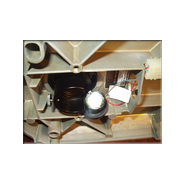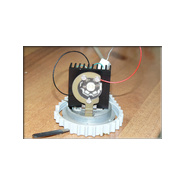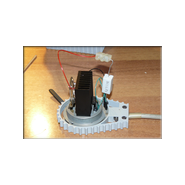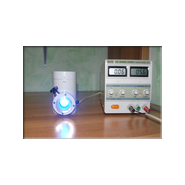www.fluorescencemicroscopy.it
Main menu:
- Home Page
- Microscopes
- Fluorescence
- Description
- Diascopy
- Epi-Fluoresc.
- Illumination
- Installing and Aligning a Mercury Lamp
- Fluorocromes
- Tables of Fluorocromes
- The Fading
- Wavelengths
- Properties
- % of transmission
- Types of filters
- Overlapping Spectra
- Intensity
- Image acquisition
- The Filter's set
- The Filters
- Fluorochrome's praparation
- Sample's preparations
- Fluorescence Sample
- Cytochemical Fluorescence
- Intrinsic Fluorescence
- Gallery
- Phase Contrast
- Polarization
- Darkfield
- DIC
- COL
- Rheinberg
- Brightfield
Conversion to LED
Microscopes > Standard 16
Converting Halogen to LED lighting
The conversion of the type of lighting on the Zeiss Standard 16 was necessary for the weak lamp power (just 10W). The change was made through intervention on the basis of the microscope lamp holder and lamp housing. As shown in the pictures below the bulb was unscrewed and replaced with a circular support plate (heat sink) where it was previously glued the LED in question, a LUXEON 5W cold light. Then the LED is connected to a power supply with manual calibration for adjusting the intensity of illumination. The result was excellent. You should keep in mind that the LED develops, even though minimal, UV light source, so it is advisable to affix above the light source a UV filter. Evidence of this is the fact that if we try to resolve striae of diatoms difficult to solve, as the Amphipleura Pellucida, we will see that the results, using an LED of this type, will be much more efficient than those obtained with the halogen lamp.




Regarding the illuminator for EPI-Fluorescence, also here we can unscrewed the newsstand socket and inserted, in place of this, a heat sink square shape where it was previously glued the LED. In one of the photos below was maintained the support containing the frosted glass, used to attenuate, optionally, the strong intensity of the HBO 50/100W or halogen lamp. In this case I suggest to remove the same for not decrease the already low power LED . For Fluorescence I used three types of LEDs, Green for the band at 480nm, (FITC excitation), Red for band at 580nm, (TRITC excitation), UV for band at 300 nm (DAPI excitation). LEDs of this type may be found at major retailers of diodes. Is recommended a power of at least 5W.
For both realizations are the important points to consider.LED should not consist of multiple LED or more CHIP, this would certainly lead to increased power of the light source but this power would not be fully utilized by the microscope objectives, which are in need of a point-like light as much as possible, light which then must be converted into light beam through the condenser in the case of transmitted light (Diascopia) or the lamp housing in the case of Episcopia.
The LEDs must be protected by appropriate resistance, by choose according to the power of the diode, to prevent voltage fluctuations that may affect the duration of the same.
The white LEDs, those cold light, do not need a blue filter to correct the color of the light, which is, however, used for illumination with halogen lamp.


